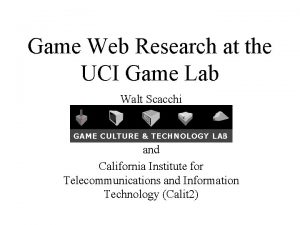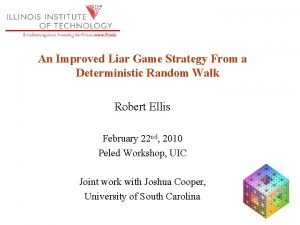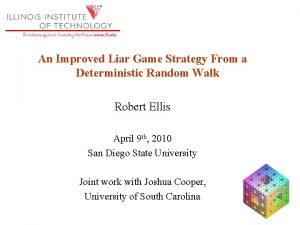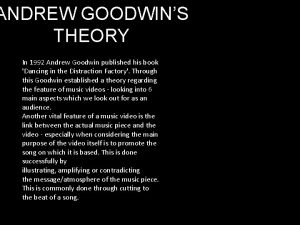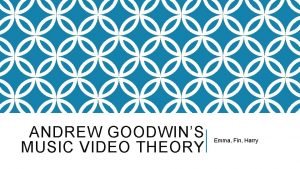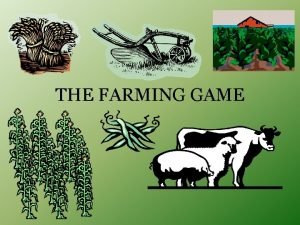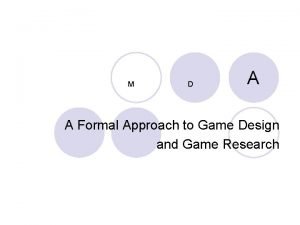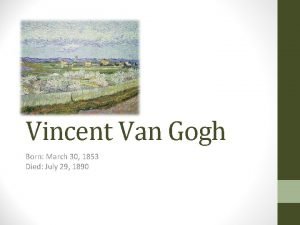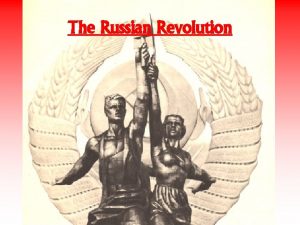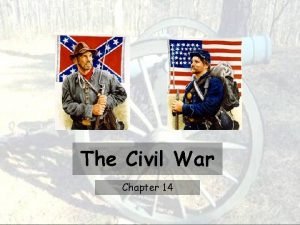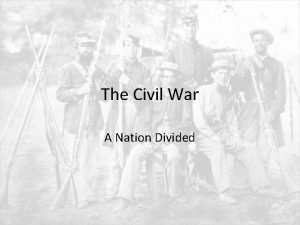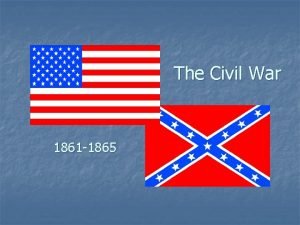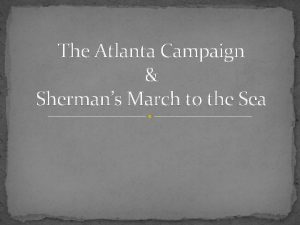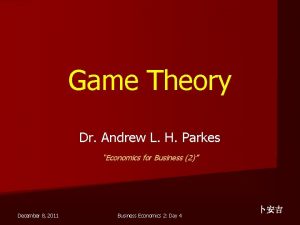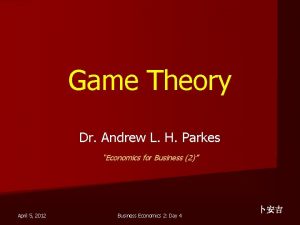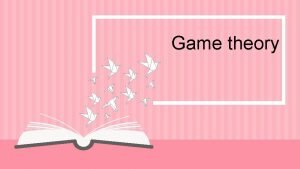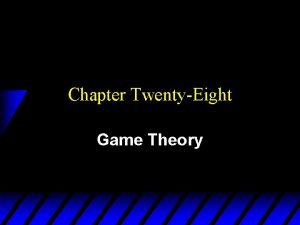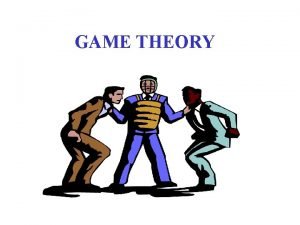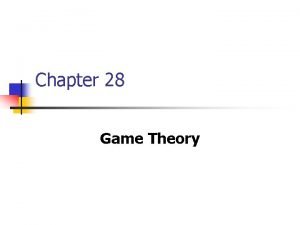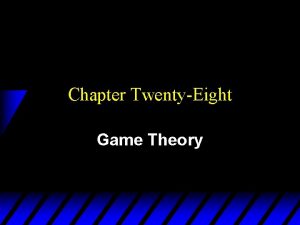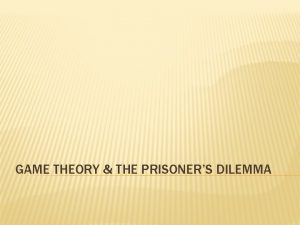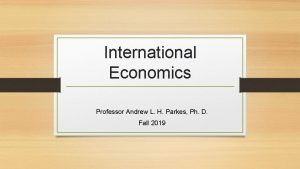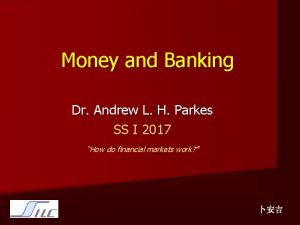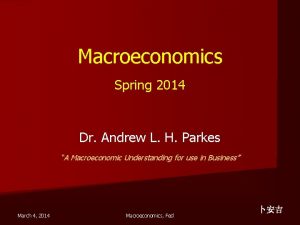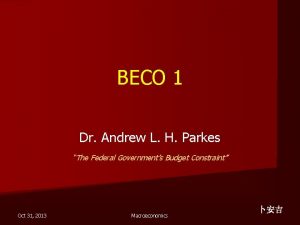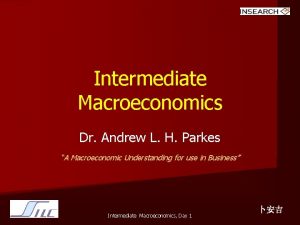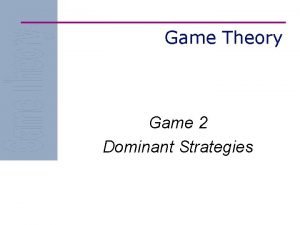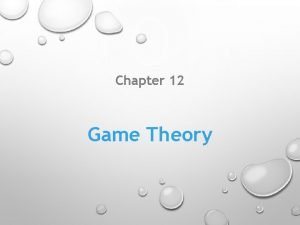Game Theory Dr Andrew L H Parkes March






















- Slides: 22

Game Theory Dr. Andrew L. H. Parkes March 15, 2018 卜安吉

Nobel Memorial Prize in Economics n Eight gametheorists have won the Nobel Memorial Prize in Economic Sciences March 15, 2018 2

John von Neuman A brilliant mathematician who’s paper in 1928 was a significant milestone in creating the field of game theory. March 15, 2018 3

John von Neuman n was a Hungarian-American mathematician and polymath who made major contributions to a vast number of fields. n Von Neumann founded the field of game theory as a mathematical discipline. Von Neumann proved his minimax theorem in 1928. March 15, 2018 4

John Von Neuman n This theorem establishes that in zero-sum games with perfect information (i. e. , in which players know at each time all moves that have taken place so far), there exists a pair of strategies for both players that allows each to minimize his maximum losses (hence the name minimax). March 15, 2018 5

Zero Sum Games n Zero-sum games are those in which one person's gains exactly equal net losses of the other participant(s). March 15, 2018 6

Perfect Information n Perfect information means that players know at each time all moves that have taken place so far. March 15, 2018 7

A Nash Equilibrium n… is the solution to a game involving two or more players when each player takes into account the other players’ known strategies. Jon Forbes Nash A genius mathematician who created what has become known as the Nash Equilibrium. March 15, 2018 8

A Nash Equilibrium n. A John Nash is the subject of the Hollywood movie A Beautiful Mind. Russell Crowe plays his part … Nash Equilibrium results when no player can improve their situation as long as others do not change their positions. March 15, 2018 9

Understanding Oligopoly § Some of the key issues in oligopoly can be understood by looking at the simplest case, a duopoly. § An oligopoly consisting of only two firms is a duopoly. Each firm is a duopolist. § With only two firms in the industry, each would realize that by producing more, it would drive down the market price. So each firm would, like a monopolist, realize that profits would be higher if it limited its production. March 15, 2018 10

Understanding Oligopoly § One possibility is that the two companies will engage in collusion. Sellers engage in collusion when they cooperate to raise each others’ profits. § The strongest form of collusion is a cartel, an agreement by several producers to obey output restrictions in order to increase their joint profits. § They may also engage in non-cooperative behavior, ignoring the effects of their actions on each others’ profits. March 15, 2018 11

Understanding Oligopoly § By acting as if they were a single monopolist, oligopolists can maximize their combined profits. So there is an incentive to form a cartel. § However, each firm has an incentive to cheat—to produce more than it is supposed to under the cartel agreement. So there are two principal outcomes: successful collusion or behaving non-cooperatively by cheating. § When firms ignore the effects of their actions on each others’ profits, they engage in non-cooperative behavior. It is likely to be easier to achieve informal collusion when firms in an industry face capacity March 15, 2018 12 constraints.

Competing in Prices vs. Competing in Quantities § Firms may decide to engage in quantity or price competition. § The basic insight of the quantity competition (or the Cournot model) is that when firms are restricted in how much they can produce, it is easier for them to avoid excessive competition and to “divvy up” the market, thereby pricing above marginal cost and earning profits. § It is easier for them to achieve an outcome that looks like collusion without a formal agreement. March 15, 2018 13

Competing in Prices vs. Competing in Quantities § The logic behind the price competition (or the Bertrand model) is that when firms produce perfect substitutes and have sufficient capacity to satisfy demand when price is equal to marginal cost, then each firm will be compelled to engage in competition by undercutting its rival’s price until the price reaches marginal cost—that is, perfect competition. March 15, 2018 14

The Prisoners’ Dilemma § When the decisions of two or more firms significantly affect each others’ profits, they are in a situation of interdependence. § The study of behavior in situations of interdependence is known as game theory. March 15, 2018 15

The Prisoners’ Dilemma § The reward received by a player in a game—such as the profit earned by an oligopolist—is that player’s payoff. § A payoff matrix shows how the payoff to each of the participants in a two player game depends on the actions of both. Such a matrix helps us analyze interdependence. March 15, 2018 16

A Payoff Matrix Ajinomoto Produce 30 million pounds Produce 40 million pounds Ajinomoto makes $180 million profit. Ajinomoto makes $200 million profit. Produce 30 million pounds ADM makes $150 million profit ADM makes $180 million profit Ajinomoto makes $160 million profit. Ajinomoto makes $150 million profit. Produce 40 million pounds ADM makes $160 million profit ADM makes $200 million profit March 15, 2018 17

The Prisoners’ Dilemma § Economists use game theory to study firms’ behavior when there is interdependence between their payoffs. The game can be represented with a payoff matrix. Depending on the payoffs, a player may or may not have a dominant strategy. § When each firm has an incentive to cheat, but both are worse off if both cheat, the situation is known as a prisoners’ dilemma. § The game based on two premises: (1) Each player has an incentive to choose an action that benefits itself at the other player’s expense. (2) When both players act in this way, both are worse off than if they had acted cooperatively. March 15, 2018 18

The Prisoners’ Dilemma Louise Don’t confess Louise gets 5 -year sentence. Confess Louise gets 2 -year sentence. Don’t confess Thelma gets 5 -year sentence. Louise gets 20 -year sentence. Thelma gets 20 -year sentence. Louise gets 15 -year sentence. Confess Thelma gets 2 -year sentence. March 15, 2018 Thelma gets 15 -year sentence. 19

The Prisoners’ Dilemma § An action is a dominant strategy when it is a player’s best action regardless of the action taken by the other player. Depending on the payoffs, a player may or may not have a dominant strategy. § A Nash equilibrium, also known as a noncooperative equilibrium, is the result when each player in a game chooses the action that maximizes his or her payoff given the actions of other players, ignoring the effects of his or her action on the payoffs received by those other players. March 15, 2018 20

Overcoming the Prisoners’ Dilemma Repeated Interaction and Tacit Collusion § Players who don’t take their interdependence into account arrive at a Nash, or non-cooperative, equilibrium. But if a game is played repeatedly, players may engage in strategic behavior, sacrificing short-run profit to influence future behavior. In repeated prisoners’ dilemma games, tit-for-tat is often a good strategy, leading to successful tacit collusion. § Tit-for-tat involves playing cooperatively at first, then doing whatever the other player did in the previous period. § When firms limit production and raise prices in a way that raises each others’ profits, even though they have not made any formal agreement, they are engaged in tacit collusion. March 15, 2018 21

How Repeated Interaction Can Support Collusion Ajinomoto Tit for tat Always cheat Ajinomoto makes $180 million profit each year. Ajinomoto makes $200 million profit 1 st year, $160 profit each later year. Tit for tat ADM makes $180 million profit each year. Always cheat Ajinomoto makes $150 million profit 1 st year, $160 million profit each later year. ADM makes $200 million profit 1 st year, $160 million profit each later year. ADM makes $150 million profit 1 st year, $160 million profit each later year. Ajinomoto makes $160 million profit each year. ADM makes $160 million profit each year. March 15, 2018 22
 March march dabrowski
March march dabrowski How are they used?
How are they used? Miles parkes
Miles parkes Parkes observatory tours
Parkes observatory tours Dr peter parkes
Dr peter parkes Pirate grid game
Pirate grid game Game lab game theory
Game lab game theory Liar game game theory
Liar game game theory Liar game game theory
Liar game game theory Game theory and graph theory
Game theory and graph theory Andrew goodwin theory
Andrew goodwin theory Emma krotos
Emma krotos The farming game rules
The farming game rules A formal approach to game design and game research
A formal approach to game design and game research Grihalakshmi magazine march 2019
Grihalakshmi magazine march 2019 Van gogh born
Van gogh born Source russia march
Source russia march March 1917 revolution
March 1917 revolution Sherman's march to sea map
Sherman's march to sea map Sherman's march significance
Sherman's march significance Path of sherman's march to the sea
Path of sherman's march to the sea Path of sherman's march to the sea
Path of sherman's march to the sea Algorithm march
Algorithm march






